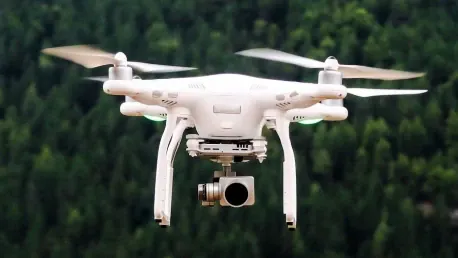Power line inspection has traditionally been a labor-intensive and time-consuming task, often requiring experts to work in hazardous conditions. However, advancements in technology are paving the way for safer, more efficient solutions. One of the most transformative innovations in this domain is the integration of AI-driven drone technology. This article delves into how this cutting-edge tech is revolutionizing power line inspections, saving both time and money while enhancing safety.
The Intersection of Drone Technology and AI
In the past, power line inspections involved manual checking by technicians, necessitating long hours and posing significant safety risks. The advent of drone technology has dramatically changed this landscape. Drones equipped with advanced imaging systems can autonomously navigate power lines, capturing high-resolution images and videos of the infrastructure. This technology allows for a more holistic view of power line conditions, pinpointing issues that might be missed in traditional inspections due to inaccessible spots and human error.
The integration of Artificial Intelligence (AI) further augments the capabilities of these drones. By combining machine learning algorithms with real-time data processing, AI-driven drones can identify defects such as broken strands, corrosion, and foreign objects on power lines with remarkable accuracy. AI’s ability to process vast amounts of data quickly enhances the precision and reliability of the inspections. The synergy between drone technology and AI not only streamlines the inspection process but also ensures higher precision in defect detection. This fusion is transformative, setting new standards for how power line inspections are conducted.
Enhancing Efficiency and Cost-Effectiveness
One of the most notable advantages of AI-driven drone inspections is the significant improvement in efficiency. Traditional inspection methods can take days or even weeks to cover extensive power lines. In contrast, AI-embedded drones can perform the same tasks in a fraction of the time—up to 90% faster, according to recent studies. This efficiency stems from the drones’ ability to continuously fly over long stretches of power lines without the need for frequent breaks or shifts in personnel, thus offering a continuous and comprehensive inspection.
This efficiency translates into substantial cost savings. By reducing the time and labor required for inspections, utility companies can lower their operational expenses by as much as 50%. These savings affect the bottom line and allow companies to allocate resources more effectively, potentially investing in other critical areas of infrastructure and maintenance. The cost-effectiveness of AI-driven drone inspections is particularly appealing for utility companies operating extensive networks, where traditional methods would be prohibitively expensive and time-consuming.
Safety and Risk Mitigation
Safety is a paramount concern in power line inspections. Traditional methods often expose workers to hazardous conditions, including heights, live electricity wires, and difficult terrain. AI-driven drones fundamentally alter this equation by minimizing human involvement in risky environments. These drones can operate in challenging conditions, such as mountainous regions or areas affected by natural disasters, where manual inspections would be perilous. By eliminating the need for human inspectors to physically navigate these dangerous environments, the risk of accidents and injuries is significantly reduced.
Equipped with real-time defect detection capabilities, drones can preemptively identify potential issues, reducing the risk of power outages or catastrophic failures. The result is a safer, more reliable power grid, with fewer incidents and better overall service continuity. This shift not only enhances the safety of workers but also ensures end-users experience fewer disruptions in their power supply. The ability to quickly and accurately detect problems before they escalate is a game-changer for the industry, promoting a culture of proactivity rather than reactivity in maintenance.
Real-World Applications and Success Stories
The practical applications of AI-driven drone technology in power line inspections are far-reaching. For instance, Taiwan’s Industrial Technology Research Institute (ITRI) developed the Power Hawk Inspector, a system that has been successfully deployed by Taiwan Power Company (TPC). Over 6,000 kilometers of transmission lines have been inspected using this AI-embedded drone system, showcasing its effectiveness and reliability. The Power Hawk Inspector represents a significant leap forward in inspection technology, evidencing tangible benefits such as reduced inspection times and heightened accuracy.
The Power Hawk Inspector’s success has led to its adoption by other utility companies across Taiwan, setting a precedent for global implementation. Such stories underscore the potential of AI-driven drone technology to become a standard practice in power line inspections, addressing long-standing challenges in the industry. The widespread acceptance and positive reception of the Power Hawk Inspector provide a compelling case for other utility companies worldwide to consider adopting similar technologies to enhance their operations.
Recognition and Future Prospects
Inspecting power lines has long been a labor-intensive, time-consuming task that often puts experts in dangerous situations. Traditionally, this work required teams to physically examine every inch of the power lines, often in high-risk environments such as remote forests, mountainous terrain, or areas prone to extreme weather conditions. This lengthy process not only compromised worker safety but also led to higher operational costs. However, advances in technology are now offering more efficient and safer alternatives. One of the most groundbreaking developments in this field is the use of AI-driven drone technology for power line inspections.
These drones, equipped with advanced sensors and cameras, can quickly and efficiently scan power lines, capturing high-resolution images and data. The integration of artificial intelligence allows these drones to analyze the collected data in real time, identifying potential issues such as wear and tear, corrosion, or vegetation encroachment. This automated process significantly reduces the need for manual inspections, lowering the risk to human workers and cutting down on costs and time. This article explores how AI-driven drones are revolutionizing the practice of power line inspections, enhancing safety, speed, and efficiency.









